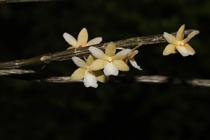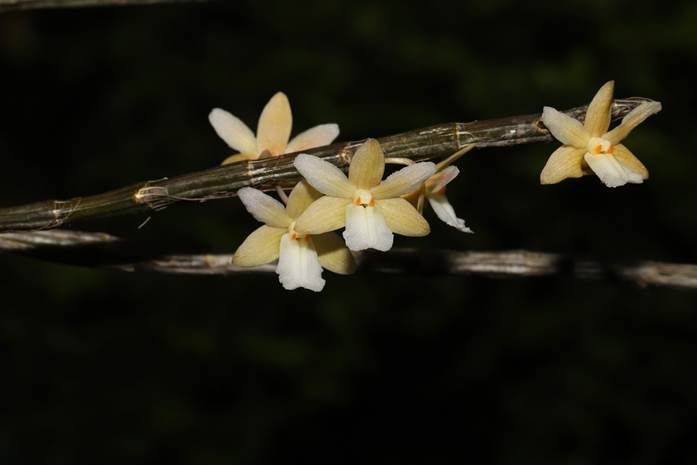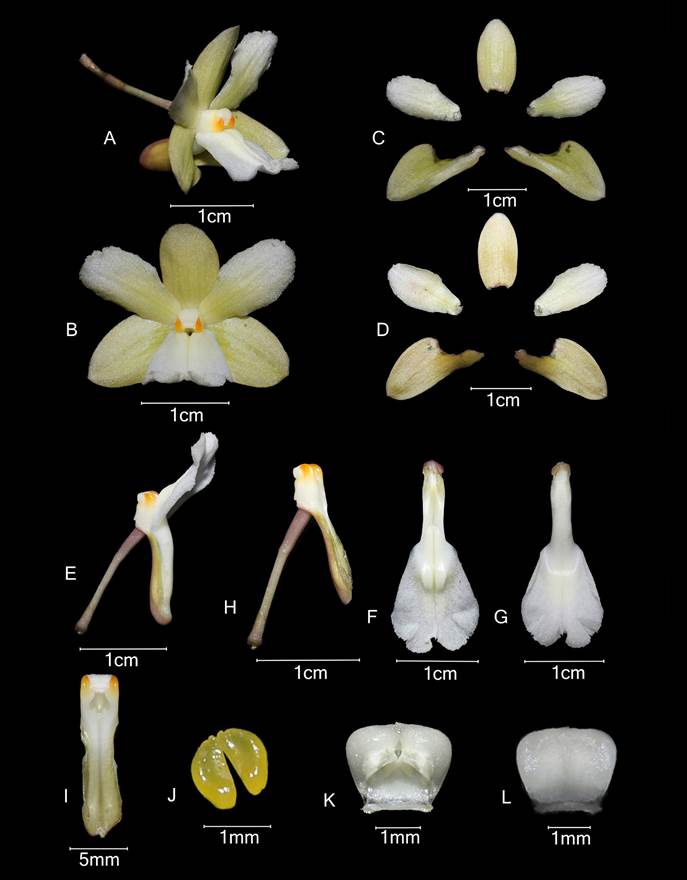Abstract
Dendrobium derryi, a new addition to the orchid flora of India, has been discovered in Karbi Anglong district of Assam. This article provides an updated description of the species, accompanied by detailed photos and line drawings based on material collected within the country.
Keywords: Dendrobium sect. Calcarifera; Dendrobium species; Hamren; Karbi Anglong; new record
Introduction
Dendrobium Sw. is one of the largest genera within the Orchidaceae, comprising approximately 1450 species (Schuiteman 2014). It is also one of the most important in commercial horticulture. The genus was established by O. Swartz in Nova Acta Regiae Societatis Scientiarum Upsaliensis in 1799 (Chen et al. 2009). Dendrobium is widely distributed throughout India, across to Japan, south to Malaysia and Indonesia, and east to Australia, New Guinea, and the Pacific Islands (Chen et al. 2009, Garay & Sweet 1974, Pearce & Cribb 2002, Seidenfaden 1985, Tsi 1999, Wood 2006).
In India, the genus is widely distributed in the Eastern Himalayas, Western Himalayas, Western Peninsular, Andaman and Nicobar Islands (Misra 2019). As many as 32 species have been recorded from Sikkim Himalaya (King & Pantling 1898), 15 species from the North-West Himalaya (Deva & Naithani 1986), 47 species from Arunachal Pradesh (Chowdhery 1998), 45 species from Sikkim and the North East Himalaya (Lucksom 2007), 82 species from Northeast India (Lokho 2013), and 12 species from Odisha (Misra 2014). Hooker (1888-1890) recorded 158 species from British India, while Pradhan (1979) reported 66 species from India in his work ‘Indian Orchids Guide to Identification and Culture, Vol-II’. Bose et al. (1999) reported 91 Species from India. According to a recent report, the genus is represented by 124 species (Deori et al. 2019), and according to Misra (2019), it is 137 species, out of which 97 species are from the northeast region (Deori et al. 2019) and nearly 57 species in Assam (Gogoi 2018, 2019).
The Dendrobium sect. Calcarifera was first published by J. J. Smith in 1908 and later revisited by Comber (1983). While D. derryi is known in regions like Sumatra, Borneo, and peninsular Malaysia (POWO 2023), it has never been documented in India. This manuscript records this species for the first time in India providing a comprehensive description, illustrations, and information on its habitat and distribution.
Materials and methods
Fresh plant material in its vegetative condition was collected during a botanical excursion on March 16, 2012, in Hamren, located in the Karbi Anglong district of Assam, India. This material was subsequently planted at the Regional Orchids Germplasm Conservation and Propagation Centre (Assam Circle). Measurements and species descriptions of both vegetative and reproductive characters were conducted after flowering, using living plants, and followed the terminology for morphological descriptions as outlined by Beentje (2012). All photographs were taken using a Canon 6D Mark-II camera fitted with an EF 100 mm f/2.8L Macro USM lens. A voucher specimen has been deposited at TOSEHIM (Herbarium of The Orchid Society of Eastern Himalaya), Regional Orchid Germplasm Conservation and Propagation Centre (Assam Circle), Assam.
Taxonomic treatment
Dendrobium derryiRidl. in Mat. Fl. Malay. Penins. 1: 52. 1907. (Fig. 1, 2, 3).
TYPE: Peninsular Malaysia. Larul Hills, Derry sn. (holotype: SING).
Plant epiphytic. Stems erect when young, pendant when old, 35−80 cm long; internodes 1−4 cm long, 0.5−0.8 cm in diameter, subterete. Leaves many, deciduous, 6−10 × 1.5−3.5 cm, oblong to narrowly elliptic, apex sub oblique, acute, shiny ash-grey or pearl-grey above, dark violet below, sheathed; sheath 3−3.5 cm long, tubular, apex truncate, dingy green suffused violet, with greenish violate nerves. Inflorescence borne on nodes of leafless stems, 1−2 flowered, sessile, pendent; rachis 0.3 cm long, olive-green, or dirty violet; floral bracts 0.2−0.3 cm long, triangular, acute, pale green or purplish. Flowers 2−3 cm long, 2−2.5 cm across; pedicel with ovary pinkish mauve, sepals, and petals greenish white or pale yellowish, lip white with base pale yellow, column white with orange apical stelidia, anther cap white. Pedicel with ovary 1.4−1.6 cm long. Dorsal sepals 1.1−1.5 × 0.5−0.8 cm, oblong, obtuse; lateral sepals 1.8−2.0 × 0.6−0.8 cm, obliquely triangular-oblong, obtuse, minutely apiculate. Petals 1.4−1.5 × 0.6−0.7 cm, oblong or spathulate, rounded, obtuse, often minutely erose, reflexed. Mentum 1.2−1.5 cm long, 0.4−0.5 cm wide, sub-cylindrical, obtuse, sightly laterally compressed, spur-like, gently decurved. Lip 2.3−2.5 cm long, blade 1.3−1.4 × 1.0−1.2 cm, spathulate to broadly rounded or rarely almost orbicular, retuse to bilobulate, with a minute mucro in the sinus, recurved, strongly convex, margin undulate; disc of blade with 2 longitudinal low, raised central keels separated by a groove. Column 0.4−0.5 × 0.3−0.4 cm; stelidia 0.1 cm, obliquely quadrangular, distally slightly recurved and hooked, clasping anther cap, obtuse; foot 1.2−1.4 cm long, canaliculate; anther cap 2.0 × 2.0−2.1 mm, quadrangular, cucullate.
Specimen examined: India. Assam: Karbi Anglong, Hamren, 16 March 2012, fl. 20 May 2023 in the Orchids Germplasm Conservation and Propagation Centre (Assam Circle), Gogoi 01147 (TOSEHIM!).
Flowering: From March to August.
Habitat: Epiphytic in evergreen forests at 400 m in Hamren of Karbi Anglong district, Assam.
General distribution: Peninsular Malaysia, Sumatra, Borneo, and now India (Assam).
Conservation status: The species was previously known from a single locality. The degradation of its habitat due to shifting cultivation and illegal logging may pose a threat to the species in the near future.
Note: The species D. derryi was initially reported from Borneo, Malaya, and Sumatra. In this correspondence, this species is reported from Karbi Anglong district of Assam, an easternmost state of India. This transition of D derryi is very interesting from a geographical point of view. At the same time, the current finding also depicts that present-day South East Asia was a single landmass and drifted to different landmasses in due course of time, hence the relatives of the taxon still existed in different pockets.
Discussion
This species belongs to Dendrobium sect. Calcarifera, characterized by verrucose-papillose roots, fleshy or pseudobulbs, often-pendulous stems with semi-deciduous leaves arranged in two ranks (Smith 1908). The stems typically produce multiple growths each year, both producing racemose inflorescences, short and pendent, on newer and older leafless stems, with the pedicel attached at a right angle to the long, spur-like mentum. Additionally, the lip has a distinct claw, often bearing a projection or tooth on its upper side near the base, abruptly broadening above with or without side lobes and a retuse and bilobed apex.
In India, there are three species in Sect. Calcarifera: Dendrobium cumulatum Lindl. (1855), D. parcum Rchb.f. (1866), and D. rhodocentrum Rchb.f. (1872). With the recent discovery of D. derryi in Assam, the total number of species in this section has increased to four. Dendrobium derryi shares morphological similarities with D. cumulatum Lindl. but can be distinguished by its inflorescences with a 0.3 cm long rachis and 1−2 flowers, white or pale yellowish flowers, and a lip that is white, spathulate to broadly rounded or orbicular, retuse to bilobulate, with a small mucro in the sinus. The blade’s disc possesses two longitudinal low, raised central keels separated by a groove.
Conclusions
Karbi Anglong district in Assam, Northeast India, boasts agroclimatic conditions ideal for the establishment of a diverse range of orchid species in their native environments. To date, 106 orchid species have been identified in Karbi Anglong, including 12 Dendrobium species (Gogoi & Yonzone 2013). While there have been studies on the orchids of Karbi Anglong, efforts toward their preservation and propagation remain insufficient. The entire orchid family is under significant threat due to ongoing habitat destruction from deforestation, shifting cultivation, industrial activities, soil erosion, overgrazing, and particularly the unregulated collection for the floral trade. Such activities have jeopardized the native orchid populations, with a looming risk of extinction if their habitats are not safeguarded. It is imperative to prioritize habitat conservation in this region to ensure the continued existence of this rich orchid diversity for future generations.
Key to the species of Dendrobium sect. Calcarifera from India
Inflorescence corymbose or sub- corymbose………………………………………………..2
Mentum short, column with tuft of hairs………...……………...…D. rhodocentrum
2b. Mentum long, column not hairy………………………..………………….………...3
Inflorescence 1−2-flowered………………………………………………….D. derryi
3b. Inflorescence 2−7-flowered……………………………...……….D. cumulatum
Inflorescence terminal or axillary…………………………………………….D. parcum
Acknowledgements
I extend my gratitude to the Department of Forest in Karbi Anglong District, Assam, for their continuous supervision and valuable suggestions during this study. I also thank Ba Vuong Truong of Vietnam for their assistance and valuable suggestions in identifying the species.
Literature cited
- Beentje, H. (2012). The Kew Plant Glossary, an illustrated dictionary of plant terms (revised edition). Kew: Royal Botanic Gardens, Kew Publishing. 170 p.
- Bose, T. K., Bhattacharjee, S. K., Das, P. & Basak, U.C. (1999). Orchids of India Calcutta, India: Naya Prokash.
- Chen, S. C., Liu, Z., Zhu, G., Lang, K. Y., Tsi, Z. H., Luo, Y., Jin, X., Cribb, P. J., Wood, J. J., Gale, S. W., Ormerod, P., Vermeulen, J. J., Wood, H. P., Clayton, D. & Bell, A. (2009). Orchidaceae. In: Z. Wu, P. H. Raven & D. Hong (eds), Flora of China, vol. 25. Science Press, Beijing, China and Missouri Botanical Garden Press, St. Louis, USA. 570 p.
- Chowdhery, H. J. (1998). Orchid Flora of Arunachal Pradesh Dehra Dun, India: Bishen Singh Mahendra Pal Singh. 824 p.
- Comber, J.B. (1983). The section Calcarifera of the genus Dendrobium in Java Orchids. Orchid Digest, 47(5), 191-196.
- Deori, C., Sarma, S. K. & Hynniewta, T. M. (2019). Dendrobium Orchids of Northeast India Guwahati, Assam: Purbayon Publication. 404 p.
- Deva, S. & Naithani, H. B. (1986). The Orchid Flora of North West Himalayas New Delhi: Print and Media Associate.
- Garay, L. A. & Sweet, H. R. (1974). Orchids of Southern Ryukyu Islands Massachusetts, U.S.A.: Harvard University Cambridge. 180 p.
- Gogoi, K. (2018). Wild Orchids of Assam - A Pictorial Guide Guwahati, Assam: Assam State Biodiversity Board. 473 p.
- Gogoi, K. (2019). Orchids of Assam - A Pictorial Guide Dibrugarh, Assam: Dibrugarh University. 588 p.
- Gogoi, K. & Yonzone, R. (2013). Orchids of The Karbi Anglong District of Assam, India (Part-I) in The McAllen International Orchid Society Journal, 14(4), 11-20.
- Hooker, J. D. (1888−1890). Flora of British India Vols 5 & 6. London: L. Reeve and Co.
- King, G. & Pantling, R. (1898). The orchids of the Sikkim Himalayas Annals of the Royal Botanical Garden Calcutta, 8, 1-342, tt. 1-448.
- Lindley, J. (1855). Dendrobium cumulatum Lindl. The Gardeners’ chronicle, 756.
- Lokho, A. (2013). Diversity of Dendrobiums sw. Its distributional patterns and present status in the northeast india. International Journal of Scientific and Research Publications, 3(5), 1−8.
- Lucksom, S. Z. (2007). The Orchids of Sikkim and North East Himalaya Gangtok, East Sikkim, India: Development Area, Jiwan Thing Marg. 984 p.
- Misra, S. (2014). Orchids of Odisha, A Handbook Dehra Dun, India: Bishen Singh Mahendra Pal Singh. 424 p.
- Misra, S. (2019). Orchids of India- a hand book Dehra Dun, India: Bishen Singh Mahendra Pal Singh. 652 p.
- Pearce, N. R. & Cribb, P. J. (2002). Orchids of Bhutan: Flora of Bhutan Vol. 3, No. 3. Edinburg: Royal Botanical Garden. 643 p.
-
POWO. (2023). Plants of the World Online. Facilitated by the Royal Botanic Gardens, Kew. Retrieved from Retrieved from https://powo.science.kew.org/
Accessed 22 July 2023.
» https://powo.science.kew.org/ - Pradhan, U. C. (1979). Indian Orchids Guide to Identification and Culture, Vol II. (pp. 190-747). Faridabad, India: Thomson Press.
- Reichenbach f., H. G. (1866). Dendrobium parcum Rchb.f. in The Gardeners’ chronicle, 1042.
- Reichenbach f., H. G. (1872). Dendrobium rhodocentrum Rchb.f. in The Gardeners’ chronicle, 426.
- Ridley, H. N. (1907). Materials for a flora of the Malayan peninsula Singapore: Printed at the Methodist publishing house.
- Schuiteman, A. (2014). Dendrobium In: A. M. Pridgeon, P. J. Cribb & M. W. Chase (Eds.), Genera Orchidacearum, 6, 51-73. Oxford, U.K.: Oxford University Press.
- Seidenfaden, G. (1985). Orchid genera in Thailand XII. Dendrobium Sw. Opera Botanica, 83,1−295.
- Smith, J. J. (1908). Die Orchideen von Java - Figuren Atlas. Leiden: E. J. Brill.
- Swartz, O. (1799) Dianome Epidendri generis Linn, Nova Acta Regiae Societatis Scientiarum Upsaliensis, Edman, Upsala, 6: 61-88.
- Tsi, Z. H. (1999). Flora Reipublicae Popularis Sinicae Tomus, Vol. 19. Beijing: Science Press. pp. 339-420.
- Wood, H. P. (2006). Dendrobium sections: northern clade, northern (Asian) group. In R. Schettler (ed.), Dendrobiums Ruggell: A.R.G. Gantner Verlag K.G.
Publication Dates
-
Date of issue
Jan-Apr 2024
History
-
Received
05 Oct 2023 -
Accepted
20 Nov 2023

 Denbrodium derryi (Epidendroideae: malaxideae): an addition to the flora of India
Denbrodium derryi (Epidendroideae: malaxideae): an addition to the flora of India



 Close-up of the flowers in its natural habitat.
Close-up of the flowers in its natural habitat.
 Photos by K.Gogoi.A. Side view of flowers. B. Ventral view of flower. C. Ventral view of perianth. D. Dorsal view of perianth. E. Lip with ovary & column. F. Dorsal view of lip. G. Ventral view of lip. H. Ovary with pedicel and column. I. Front view of Column. J. Ventral view of pollinarium. K. Anther cap dorsal view. L. Anther cap ventral view.
Photos by K.Gogoi.A. Side view of flowers. B. Ventral view of flower. C. Ventral view of perianth. D. Dorsal view of perianth. E. Lip with ovary & column. F. Dorsal view of lip. G. Ventral view of lip. H. Ovary with pedicel and column. I. Front view of Column. J. Ventral view of pollinarium. K. Anther cap dorsal view. L. Anther cap ventral view.
 Drawing by K.Gogoi.A. Habit. B. Side view of flower. C. Ventral view of flower. D. Ventral view of perianth. E. Lip with ovary & column. F. Dorsal view of lip. G. Ventral view of lip. H. Ovary and column with the foot. I. Front view of Column. J. Ventral view of pollinarium. K. Anther cap dorsal view. L. Anther cap ventral view.
Drawing by K.Gogoi.A. Habit. B. Side view of flower. C. Ventral view of flower. D. Ventral view of perianth. E. Lip with ovary & column. F. Dorsal view of lip. G. Ventral view of lip. H. Ovary and column with the foot. I. Front view of Column. J. Ventral view of pollinarium. K. Anther cap dorsal view. L. Anther cap ventral view.